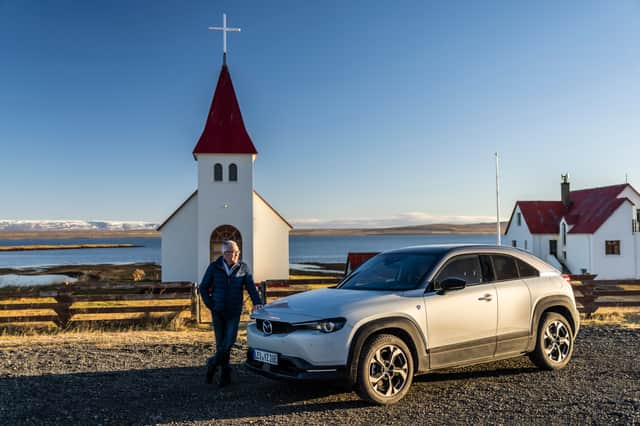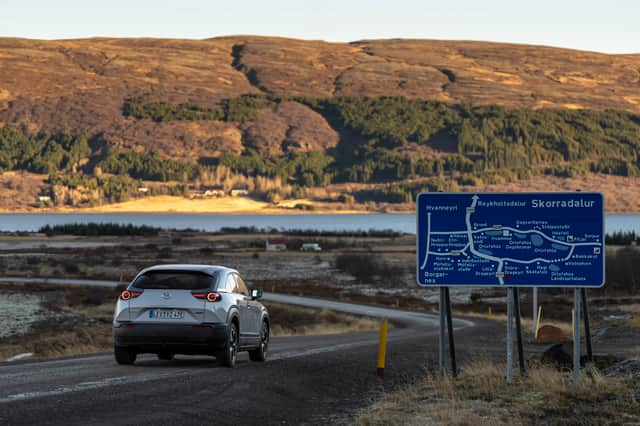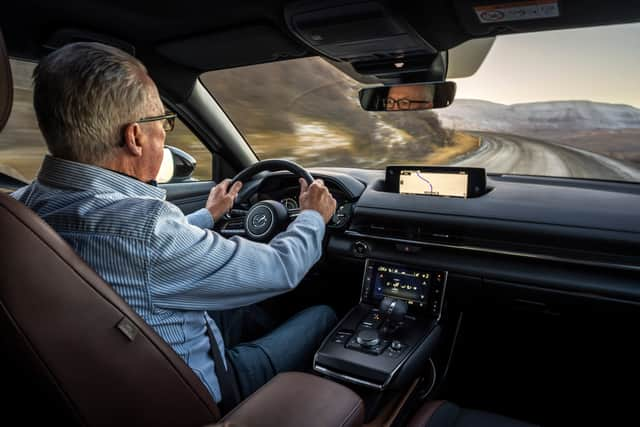Mazda MX-30 R-EV review: Novel approach to PHEV driving heralds the return of the rotary engine


Mazda’s all-electric MX-30 grabbed a lot of attention when it was launched three years ago. Its only real downside? A range of around 100 miles. But we knew then that a range extender version, a petrol-engined plug-in hybrid, was in the pipeline. So, with the extender’s key in my hands the challenge was, could I drive 560km — 350 miles — in winter conditions round northwest Iceland without refuelling the new MX-30 R-EV?
Always up for a Mazda epic drive challenge I flew into Reykjavik, where 50% of the Icelandic population live, just as the islanders were closely monitoring the thousands of earth tremors literally shaking the island daily as an underground magma flow threatened to erupt. Iceland, of course, is one of the most volcanic places on Earth, so while the locals dealt with the news as being a ‘common occurrence’, I was keeping a close eye on events.
Advertisement
Hide AdAdvertisement
Hide AdUndeterred, and buoyed by a reassuring report by the Icelandic Meteorological Office, I headed out to my range extender MX-30 in pitch darkness at 8am. Filtering through the early morning rush hour, my journey would see me head to the north-west peninsula across some of the island’s largest areas of volcanic wilderness.
But the first part of the journey was undertaken in all-electric silence as the R-EV powered itself solely on electric power. Perhaps worth highlighting here that at the core of the range extender is a rotary engine.


The rotary engine, of course, is synonymous with Mazda, as it remains the only mainstream car manufacturer to put it into mass production. Think of some of its most iconic cars — the stunning Cosmo, plus the RX-7 and RX-8 — and under the bonnet was a rotary, or Wankel for those in the know, engine.
So, how does it all work? In typical Mazda fashion, ingeniously. In simple terms, the rotary engine provides energy for the electric motor which actually drives the front wheels. It never powers the front wheels directly itself, so the R-EV is always powered by electric. Clever, eh?
One of the main benefits of the rotary is its ability to deliver power smoothly. It’s also small in terms of size and weight. In the R-EV the new-generation 830cc petrol rotary engine features a single rotor with a 120mm radius and 76mm width. Developing 73bhp, it essentially works solely as a generator to charge the battery pack.
The rotary engine works in tandem with a 17.8 kWh battery pack and a 167bhp electric motor. Tipping the scales 150kg heavier than the all-electric model, combined with the fact the R-EV’s battery back is half the size of that found in the ‘standard’ MX-30 EV, the new hybrid has an electric-only range of 53 miles.
“But isn’t that range less than half of the pure EV?”, I hear you ask? Correct. But, and it’s a significantly large but, you will never suffer range anxiety with the MX-30 R-EV. Deplete the battery fully and you can bask in the knowledge that the battery can be charged on the move using the rotary engine, maintaining and even increasing charge while you’re driving. It’s such a clever solution. And remember, Mazda says the full range for the R-EV is over 400 miles. So my 350-mile trip should be a dawdle.
Cleverly, you can maintain the state of charge yourself when you’re driving. There are three drive modes on the R-EV: Normal, EV and Charge.
Advertisement
Hide AdAdvertisement
Hide AdIn essence, they’re pretty well self-explanatory. Flick to Normal mode and the R-EV will aim to maintain close to a 45% battery charge to always make sure there’s enough punch available; in EV mode the car will run on e-power only until the battery is completely depleted; and Charge allows you to reserve a certain amount of battery charge to meet your specific requirements later in your journey.
Then, when the battery level drops to the point you set in Charge mode, dips to 45% in Normal mode or depletes completely in EV mode, the rotary kicks in. Should the battery slide to zero — meaning the range extender will kick in to maintain enough power to keep the car moving — the top speed is restricted to 81mph, instead of its top speed of 87mph.
Plus, of course, the R-EV model can also be charged in traditional manner. A 20%-80% charge on a home 7.2kW charger will take around 90 minutes. That falls to 50mins on an 11kW unit, and 25 mins on a 36kW DC charger.
As I set off, the MX-30 R-EV was fully charged and brimmed with petrol. Once out of Reykjavik, and with the mode switched from EV to ‘Charge’, I headed north-west through the ever-changing scenery of mountains and dramatic seascapes towards my northernmost point at Drangsnes.


The return trip back to Reykjavik saw the crystal blue clear skies and dry gravel surfaces change to ice-covered Tarmac roads which track the coastline, and meander just a couple of metres from the crashing waves of the freezing cold Northern Atlantic. Thankfully the Mazda was fitted with studded ice tyres.
As we again climbed through the mountains, the skies closed in and for 20 minutes we lost the sun completely as the snow clouds decided to shed their icy flakes. The black ribbon of Tarmac had gone, and I was grateful for the snow posts which chart the route of the road.
Before long, darkness had again descended over Iceland and nine hours after leaving the island’s capital I was back jostling with Reykjavik commuter traffic. Flicking back into EV mode, I completed the journey on all-electric power which I had saved earlier.
So, was the drive beneficial? Unequivocally, yes. Now shorn of its restrictive 100-mile all-EV range, the MX-30 R-EV allows the driver to really engage with the car without worrying constantly about how much is left in the battery.
Facts and figures
Price: From £31,250
Powertrain: 17.8kWh battery plus 830cc rotary engine, single e-motor
Power 167bhp
Torque: 177lb/ft
Transmission: Single speed auto, front-wheel drive
Top speed / 0-62mph: 87mph / 9.1secs
EV range: 53 miles
Fuel economy: 282.5mpg
CO2: 21g/km
On sale: Now
Advertisement
Hide AdAdvertisement
Hide AdIt’s a fun car to drive, and coped admirably with whatever terrain, weather or road surface, be that city centre driving, busy dual carriageway, or ultra-remote gravel roads. In the six hours of driving in the upper northwest peninsula, I only saw another four cars on the road, that’s how remote it was.
But it’s not too remote for the Icelandic police. Two hours behind me on the road, a couple of Austrian journalists were enjoying themselves on a remote gravel section when they passed an anonymous-looking Tesla coming towards them. Seconds later, in his rear view mirror, the driver spotted the Tesla braking, turning, and following them. Then the Tesla switched on its police lights.
Turns out the police car was fitted with clever tech which could calibrate the speed of the oncoming car as they both drove towards each other. The cost to the reporter? A €500 speeding fine.
So, if you’re going to have fun in your MX-30 R-EV … stick to the speed limit.
Comments
Want to join the conversation? Please or to comment on this article.